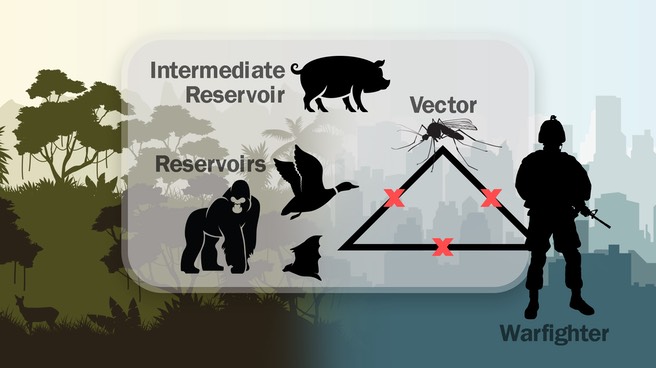What is a self-spreading vaccine?
This figure contrasts traditionally deployed vaccines that everybody is familiar with, where the vaccine is given separately to each individual, with self-spreading vaccines that are applied to a few individuals and then are intended to spread through the entire population (and ideally to newborn generations).
How a self-spreading vaccine could work in a bat population. Bats directly injected with a self-spreading vaccine passively spread the lab-modified viral vaccine to other bats they encounter over time (T1->T2->T3…) gradually building up population-wide immunity. In this example bats are used, but any mammal species that lives in groups could theoretically be targeted to rapidly vaccinate whole populations.
Image credit: Derek Caetano-Anolles
Most Viruses are unknown to science so it hard to predict which might become novel human pathogens in the future.
Global viral diversity remains largely undescribed; it is also highly dynamic. Three recent estimates of the size of the global number of viral species circulating in mammals are contrasted with the small number of described viral species recognised by the International Committee on Taxonomy of Viruses (ICTV) that are from taxonomic Families with some potential to infect vertebrates (including species not reported from vertebrates). Note that spontaneous recombination, mutation and selection are processes that will continually alter key biological properties of circulating viral species, strains and variants. It is also important to appreciate that any intervention based on attempting to substantially increase the proportion of viral diversity that has been scientifically described, needs to not only reduce the global risk of spillover of novel pathogens, but do so by more than the compounded increase in risk resulting from initiatives to sample viruses from wildlife populations and then describe them in laboratories (1).
1. M. Furmanski, Threatened pandemics and laboratory escapes: Self-fulfilling prophecies -. Bulletin of the Atomic Scientists (2014), (available at https://thebulletin.org/2014/03/threatened-pandemics-and-laboratory-escapes-self-fulfilling-prophecies/).
C. J. Carlson, C. M. Zipfel, R. Garnier, S. Bansal, Global estimates of mammalian viral diversity accounting for host sharing. Nat Ecol Evol. 3, 1070–1075 (2019).
S. J. Anthony, J. H. Epstein, K. A. Murray, I. Navarrete-Macias, C. M. Zambrana-Torrelio, A. Solovyov, R. Ojeda-Flores, N. C. Arrigo, A. Islam, S. Ali Khan, P. Hosseini, T. L. Bogich, K. J. Olival, M. D. Sanchez-Leon, W. B. Karesh, T. Goldstein, S. P. Luby, S. S. Morse, J. A. K. Mazet, P. Daszak, W. I. Lipkin, A Strategy To Estimate Unknown Viral Diversity in Mammals. mBio. 4, e00598-13 (2013).
D. Carroll, P. Daszak, N. D. Wolfe, G. F. Gao, C. M. Morel, S. Morzaria, A. Pablos-Méndez, O. Tomori, J. A. K. Mazet, The Global Virome Project. Science. 359, 872–874 (2018).
Image credit: Derek Caetano-Anolles
The PREEMPT project is focused on Mastomys rats which can act as vectors for Lassa fever (primarily Mastomys natalensis)
African mouse - Mastomys Natalensis stock photoAfrican mouse, Multimammate mouse. Females have 10-14 pairs of nipples, thus the name. Little larger than the common house mouse. Serengeti, East Africa.
license available from https://www.istockphoto.com
Image ID:D80PWA
Natal multimammate mouse (Mastomys natalensis) (or Natal multimammate rat, common African rat, or African soft-furred rat)
license available from https://www.alamy.com
These royalty free images were found using the following search and should be distributed under the terms of the Creative Commons Attribution 4.0 International License (http://creativecommons.org/licenses/by/4.0/), which permits unrestricted use, distribution, and reproduction in any medium, provided you give appropriate credit to the original author(s) and the source, provide a link to the Creative Commons license, and indicate if changes were made.
d killed, e singed, f eviscerated, and g fried L. sikapusi and Mastomys spp.
https://www.ncbi.nlm.nih.gov/pmc/articles/PMC4996873/
Small-bodied rodents including the multimammate mice (Mastomys spp) caught by children aged 6–12 in swamps.
https://www.ncbi.nlm.nih.gov/pmc/articles/PMC7968712/
Rodent burrows can be seen in the mud foundation in the exterior (Panel C) and interior (Panel D) of houses. Photos: L. Moses.
https://www.ncbi.nlm.nih.gov/pmc/articles/PMC3562201/
The EU VACDIVA project is focused on vaccinating wild boar (Sus scrofa) to protect domestic pigs (Sus domesticus)
Any stock photos of wild boars or pigs should work.
PREEMPT DARPA’s own graphics, "Prediction of spillover potential and interventional en masse animal vaccination to prevent emerging pathogen threats in current and future zones of US military operation”
Image taken from https://www.darpa.mil/news-events/2019-02-19
Based on US.GOV policy we understand that royalty free use of this image is permissible
